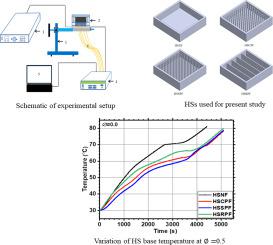Microelectronics Reliability ( IF 1.6 ) Pub Date : 2021-04-28 , DOI: 10.1016/j.microrel.2021.114144 Anuj Kumar , Rohit Kothari , Santosh Kumar Sahu , Shailesh Ishwarlal Kundalwal

|
Present experimental study reports the thermal performance of nano-enhanced phase change material (NePCM) based thermal energy storage system for cooling of electronic components. The NePCM based heat sink (HS) cooling is a passive cooling technique that can eliminate the fan-based conventional cooling technique. A plate heater was used to impersonate the heat generated by microelectronics. Here, copper oxide (CuO), paraffin wax, and aluminum are considered as nanoparticle, phase change material (PCM), and HS material, respectively. Different HS configurations such as HS with no fin (HSNF), HS with rectangular plate fins (HSRPF), HS with square pin fins (HSSPF), and HS with circular pin fins (HSCPF) are studied for a fixed volume fraction of fin material. The performance of various HS configurations are analyzed for different nanoparticle concentration (∅=0.5–3.0), and heat flux values (q′′=1.5–3.0 kW/m2). For ∅= 3.0, thermal conductivity and viscosity of NePCM are found to increase by 150% and 100%, respectively. The HSSPF involving PCM/NePCM exhibits better thermal performance compared to other HS configurations. The maximum reduction in temperature is found to be 13 °C and 15 °C for HSSPF involving PCM and NePCM (∅= 0.5), respectively. The highest enhancement ratio of 5.0 is obtained for HSSPF at q″= 2.0 kW/m2 for SPT of 65 °C. The addition of CuO nanoparticle beyond ∅=0.5 decreases the HS performance considerably.
中文翻译:

使用纳米增强相变材料(NePCM)冷却电子元件的散热器的热性能
当前的实验研究报告了基于纳米增强相变材料(NePCM)的热能存储系统的热性能,该系统用于电子部件的冷却。基于NePCM的散热器(HS)冷却是一种被动冷却技术,可以消除基于风扇的常规冷却技术。板式加热器用于模拟微电子产生的热量。在这里,氧化铜(CuO),石蜡和铝分别被视为纳米颗粒,相变材料(PCM)和HS材料。对于固定体积分数的鳍片材料,研究了不同的HS配置,例如不带鳍的HS(HSNF),带有矩形板鳍的HS(HSRPF),带有方形针鳍的HS(HSSPF)和带有圆形针鳍的HS(HSCPF)。 。2)。对于∅= 3.0,发现NePCM的热导率和粘度分别增加150%和100%。与其他HS配置相比,涉及PCM / NePCM的HSSPF具有更好的热性能。对于涉及PCM和NePCM的HSSPF,最大温度降低分别为13°C和15°C(∅= 0.5)。对于65°C的SPT,在q ” = 2.0 kW / m 2的情况下,HSSPF的最高增强比为5.0 。超过∅= 0.5的CuO纳米颗粒的加入会显着降低HS性能。











































 京公网安备 11010802027423号
京公网安备 11010802027423号